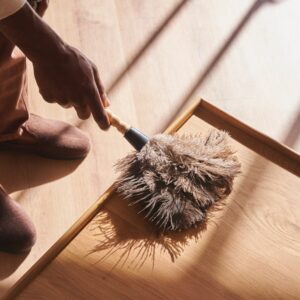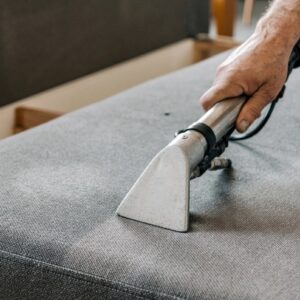Key Takeaways
- Dust comes from both indoor and outdoor sources, including fabrics, skin cells, and pet dander.
- Managing humidity levels, regular cleaning, and using high-quality air filters reduce dust significantly.
- Decluttering, washing fabrics, and sealing cracks help prevent dust buildup.
- Consistency is key to maintaining a dust-free home.
- Professional cleaning services like Clean Corps can make maintaining a dust-free home easier.
Dust buildup is a common issue in homes, often leading to allergies, respiratory discomfort, and a generally unclean environment. If you want to save time and ensure a professionally cleaned home, Clean Corps offers deep cleaning services to keep your home spotless and fresh. Understanding where dust comes from and how it behaves throughout the year can help you tackle it more effectively.
What Causes Dust Buildup at Home
Dust is composed of a combination of indoor and outdoor particles. Indoor dust often includes dead skin cells, hair, textile fibers, and pet dander. Outdoor dust comes from pollen, soil, and pollution particles that enter through windows, doors, and ventilation systems.
Common Sources of Dust
- Clothing and fabrics– Fibers from clothing, upholstery, and bedding constantly shed, contributing to indoor dust.
- Human and pet dander– Dead skin cells and pet hair are major contributors to household dust.
- Foot traffic– Shoes track in dirt, pollen, and debris from outside.
- Poor air filtration– HVAC systems that aren’t well-maintained can circulate dust.

How Dust Levels Change with the Seasons
Spring and Summer
- Higher pollen levels increase dust, especially if windows are left open.
- Increased humidity can cause dust to stick to surfaces more easily.
Fall
- Falling leaves and plant debris can enter the home through open doors and windows.
- Cooler weather means more closed windows, which can trap dust indoors.
Winter
- Indoor heating can dry out the air, increasing static electricity, which makes dust stick to surfaces.
- Reduced ventilation causes dust to accumulate more quickly.
How Dust Affects Your Home and Health
Excessive dust buildup isn’t just an aesthetic problem; it can impact your health and indoor air quality:
- Allergies– Dust mites and pet dander are common allergens.
- Respiratory issues– Fine dust particles can irritate the lungs, causing coughing and shortness of breath.
- Skin irritation– Dust particles can clog pores and cause skin sensitivity.
Overview of the 10 Most Effective Ways to Reduce Dust
- Establish a Regular Cleaning Routine
- Use a Vacuum with a High-Performance Filter
- Manage Humidity Levels
- Wash Bedding and Curtains Frequently
- Declutter Your Living Space
- Improve Air Quality with Purifiers
- Clean Air Vents and Change Filters
- Remove Shoes at the Door
- Groom Pets Regularly
- Seal Cracks and Gaps

1. Establish a Regular Cleaning Routine
Frequent cleaning prevents dust from accumulating. Focus on areas where dust collects most: shelves, baseboards, and electronics. Use microfiber cloths, which trap dust instead of spreading it. Avoid dry cloths, as they only displace dust without capturing it.
2. Use a Vacuum with a High-Performance Filter
Vacuuming is vital, but a vacuum with a fine filtration system is crucial for dust control. Standard vacuums often release fine particles back into the air. Choose models designed to trap microscopic particles and vacuum at least twice a week, especially in high-traffic areas.
3. Manage Humidity Levels
Dust thrives in dry conditions. Keeping your home’s humidity between 40% and 50% reduces static electricity, which attracts dust. Consider using a humidifier or dehumidifier to maintain optimal levels.
4. Wash Bedding and Curtains Frequently
Bedding, curtains, and upholstered furniture trap dust and dead skin cells. Wash these items weekly in hot water to eliminate allergens. Using dust-proof pillow and mattress covers adds an extra layer of protection.
5. Declutter Your Living Space
Clutter invites dust. Reducing the number of decorative items, books, and trinkets minimizes dust collection points. Store belongings in closed containers or cabinets to reduce exposure.
6. Improve Air Quality with Purifiers
Air purifiers are effective at capturing airborne particles that contribute to dust buildup. Place purifiers in high-use rooms like the living room and bedrooms for best results. Be sure to clean or replace the filters regularly to maintain efficiency.
7. Clean Air Vents and Change Filters
Your HVAC system can spread dust throughout your home if vents are dirty. Clean vents every few months and change filters at least quarterly to reduce airborne dust.
8. Remove Shoes at the Door
Shoes track dirt, debris, and dust from outdoors into your home. Establish a “no shoes indoors” rule and place a shoe rack or mat near entryways to contain dirt.
9. Groom Pets Regularly
Pets contribute fur, dander, and dirt to household dust. Brush pets frequently, preferably outdoors, and clean their bedding weekly to reduce indoor dust buildup.
10. Seal Cracks and Gaps
Dust often enters through small gaps around windows, doors, and walls. Inspect your home for gaps and seal them with caulk or weather stripping to reduce dust infiltration.
Maintaining a dust-free home can be challenging. Let Clean Corps handle the hard work for you! Our professional cleaners will help you eliminate dust and create a healthier environment.

Final Tips for Dust Prevention
- Clean ceiling fans, light fixtures, and electronics regularly as they attract a high amount of dust.
- Use damp cloths or disposable dust wipes to trap particles efficiently.
- Launder throw blankets, cushion covers, and area rugs frequently.
By incorporating these methods into your routine, you can create a cleaner, healthier living environment while reducing dust buildup effectively. Book a professional cleaning with Clean Corps today and enjoy a dust-free, fresh home without the hassle!
Conclusion
Reducing dust buildup requires a consistent effort through cleaning, managing humidity, and addressing common dust sources. By following these steps, you can maintain a cleaner, healthier home environment. Clean Corps can provide expert cleaning services to help you stay on top of dust and allergens, giving you more time to relax and enjoy your home. For deeper cleaning needs, Clean Corps offers professional services to ensure your home stays dust-free and fresh.
FAQ
- How often should I vacuum to reduce dust buildup?
Vacuuming twice a week is ideal, especially in high-traffic areas. Use a vacuum with a fine filtration system for the best results. - Can air purifiers really help with dust?
Yes, air purifiers with fine filters capture airborne particles, reducing the overall dust levels in your home. - Why is my home dusty even after cleaning?
Poor air filtration, open windows, and clutter can contribute to dust returning quickly. Regularly replacing air filters and sealing gaps can help. - How can I reduce pet-related dust?
Regular grooming and cleaning of pet bedding can significantly reduce pet dander and fur in the air. - How can I make my cleaning routine more effective?
Start from the top (ceiling fans, shelves) and work your way down. Use damp microfiber cloths to trap dust instead of moving it around.
Quality Cleaning at Your Fingertips in Orlando – Request Your Quote Today!
We’ve Received Your Order!
Thank you for reaching out to CleanCorps.
Please note that we have received your information and a dedicated advisor will be reaching out to you very soon to go through next steps.
Immediate Concerns? If you have urgent questions or matters to discuss, or if you don’t hear back from us in a few hours, please don’t hesitate to reach us directly at:
Phone: (407) 638-8956

